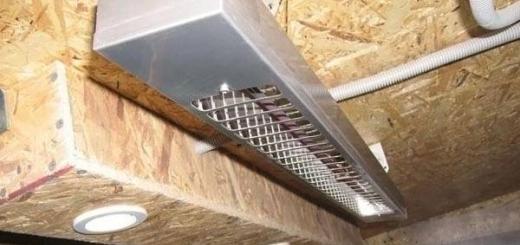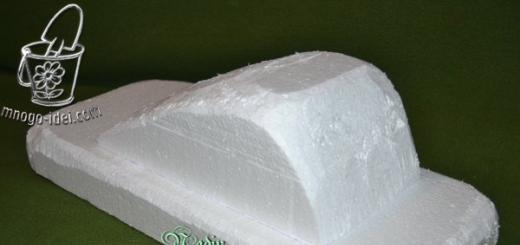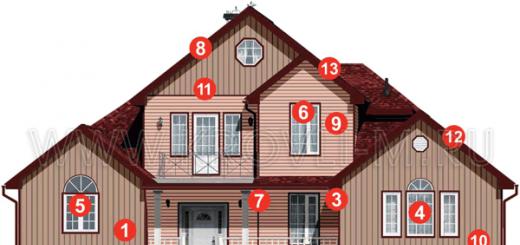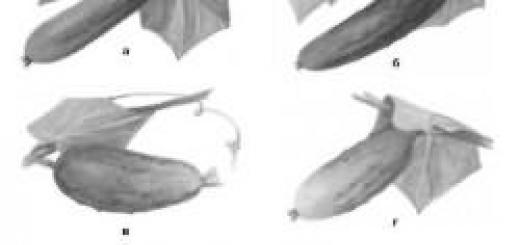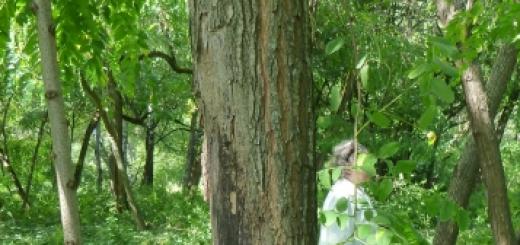For our ancestors, beans were one of the main products, so their cultivation was practiced in huge quantities. But the growing popularity of potatoes gradually displaced this crop, first from our dishes, and then from our gardens. And it’s completely in vain, because beans are unpretentious, and care is minimal, while they are very useful in nutrition.
As a garden crop, Russian beans are undeservedly forgotten, because their cultivation has many advantages: easy care, cold resistance, and also the ability to enrich the soil with nitrogen and improve its structure.

Due to its stability, caring for it eliminates the need for tying
And it’s worth returning them to the diet, because this product contains more vegetable protein than beans and peas, as well as carbohydrates, fats, vitamins, micro- and macroelements, which are so necessary for our body. And you can learn from the variety of dishes that are prepared from beans from Mediterranean, African, Mexican, Chinese cuisines and many others.
Beans as a plant can be described as follows: a thick, hollow stem, sometimes growing up to 1.5 meters in height. Thanks to its stability, caring for it eliminates the need for tying. There are usually no side branches; the leaves are large and smooth. The roots are located quite deep, especially the central one, which allows the plant to extract moisture from the lower layers of the soil. The flowers are beautiful and large, often white with black splashes. The fruits are formed in the form of elongated pods with a dense shell (the pods are many times thicker than those of beans). Up to 7-9 beans ripen in each pod.
Some characteristics may differ depending on the variety:
- Velena – medium early. The fruits are juicy without a parchment shell, pods up to 10 cm long with 3-4 beans.
- Russian black - mid-early, ripens 85-90 days after emergence. The stem is 50-60 cm high, distinguished by branching. The fruits are flat-shaped, dark purple in color, large.
- Belarusian - mid-season, reach maturity 90-110 days from germination. Plant height is from 60 to 100 cm. Cream-colored beans, weight of 1000 seeds is 1000-1200 g.
- Virovskie are mid-ripening, ripen in 80-90 days to milk ripeness and in 95-100 to technical ripeness. The stem is 85-100 cm high, the pod is slightly curved with 3-4 light-colored beans. The parchment layer is noticeable.
Video about the beneficial properties and care of beans
Growing according to all the rules
For planting beans, choose the most illuminated area. Soil moisture is also very important, so lowlands or inter-row spaces in other beds are often set aside for legumes, which makes maintenance easier. The structure of the soil is not important; beans can grow even on heavy loams, the main thing is that the soil is rich in organic matter. Therefore, agricultural technology for beans, first of all, involves the application of fertilizers. In the fall, compost, manure, mullein or humus are added to the digging. Due to its high nitrogen content, bird droppings are not recommended for beans. But they need phosphorus fertilizers, so in the fall they enrich the soil with superphosphate.
You can prepare seeds for planting at home. Before sowing, bean seeds need to be soaked for a couple of minutes in hot water (about 50 ⁰C) for disinfection. Then it is recommended to treat them with a drug that increases the yield of legumes, for example, Nitrogin. For successful germination and further cultivation, seeds need good moisture, therefore, if your country house soil is sandy and dries out quickly in the spring, it is better to wet the beans overnight before sowing so that they are saturated with moisture and their dense shell becomes softer.
Video about growing beans
Beans are sowed as early as possible. And you shouldn’t be afraid that night cold snaps can damage the seedlings; they can withstand even frosts down to -4⁰C. The main advantage of early sowing is moist soil, which promotes rapid germination. In addition, further care will not require frequent watering.
Bob is the master of the garden
There’s a whole list of benefits from growing legumes in the country! And this is not only a harvest of healthy, nutritious and, most importantly, environmentally friendly product. It is not for nothing that beans are considered the master of the garden, because they bring considerable benefits to the soil, neighboring crops, and next year’s plantings.
Video about planting and care
It should be noted the main reasons why growing them in your dacha is necessary:
- Legumes enrich the soil with nitrogen, which means they eliminate the need to use artificial mineral fertilizers.
- Beans are considered reliable protectors; during cultivation, they release phytoncides that suppress the growth of pathogenic bacteria and fungal infections.
- Planting beans improves soil structure and grows successfully even in heavy, poorly drained soil.
- They help get rid of moles - invisible, but very annoying pests that complicate the care of garden beds. It is enough to sow them around the beds and the moles will no longer be attracted to your vegetables or berries.
- Also, the cultivation of these plants is often used as green manure, sowing them mixed with mustard, rye or lupine.
As you can see, there are many benefits from beans, and agricultural technology and care for them are simple, so be sure to sow several rows in your dacha next spring!
Growing beans in open ground, subject to all agrotechnical conditions, will not only bring a lot of harvest, but will also saturate the soil with nitrogen. Further in the article there are features of planting, caring for beans and a list of the best varieties.
Botanical description of beans
Beans are annual vegetable crops. Their botanical features:
- Stem. Straight, tetrahedral, thick, reaches a height of 30-120 cm. Branches weakly.
- Leaves. They have a complex structure, consisting of 3-5 leaves.
- Root. Powerful, goes 1.5 m deep.
- Inflorescence. Racemes with 4-14 flowers in white, yellow, blue or brown. There are black spots on the wings.
- Fruit. The pods are long and can be straight or curved. Length – 4-20 cm, depends on the variety. The valves are green at the stage of technical ripeness and darken as they ripen. The pod contains seeds, in quantities of 2 pieces. Color, shape and size are determined by the variety. They are yellow, green, purple, brown, black, and variegated.
Belorussian
Tall, mid-season beans. Plant height is 1-1.4 m. One plant produces up to 6 pods. They ripen approximately 70 days after germination, and harvesting occurs after 100 days. The pods are large, not curved, each contains 3-5 fruits, tasty, juicy, fleshy. One of the most common varieties in Russia. From 1 sq. m harvest 0.5 kg of beans.

Virovsky
Mid-season variety. The ripening period to full technical ripeness is 95-102 days. The pods are slightly curved, length – 8-9 cm. The fruits are oval, whitish or lemon yellow, matte. Excellent taste during milky ripeness. Productivity – 0.56 kg per 1 sq. m.

Aushra
Fodder grade. Ripens in 120 days. The pods are 6-8 cm long. There are 3-4 beans in the pods. Drought resistant. Productivity – 29 c/ha, green mass – 340 c/ha.

Russian blacks
Mid-early, frost-resistant variety. It has a pronounced sugary taste. The plant is branched, 0.6-1 m in height. The pods are small - up to 8 cm, containing 3 beans. The taste of the fruit is delicate, juicy, sweet. By the time of technical ripeness, the seeds are light green; when fully ripe, they turn purple.
They prefer to grow in sunny areas. From 1 sq. m collect 0.5 kg. This is an old proven variety, bred in the USSR and officially registered in 1943.

Bobchinsky
Mid-early sugar variety. It takes 60-65 days from germination to technical ripeness. Plant height – 0.6 m. Pods are straight or slightly curved. Productivity 1.3-1.6 kgf 1 sq. m.

Windsor White
High-yielding variety with medium ripening periods. Brought out in Europe. It has performed well in harsh climates and can withstand spring frosts. The plant is tall, the height of the shoots is 1-1.2 m. The pods are large, fleshy, with a smooth surface. Each pod contains 2-3 milky green beans. As they ripen they turn brown.
The taste of beans is excellent, they contain a lot of vitamins A, B, C. They are very high in calories - many times higher than potatoes. Productivity – 1.6-1.8 kg per 1 sq. m.

Patio
This variety ripens earlier than others. Its main difference is its compactness. The height of the plant is no more than 30-40 cm. The variety is suitable for growing in pots - such beans can be grown on balconies and patios. The bushes quickly grow greenery; the ovaries ripen 50 days after planting. There are up to 8 fruits in one pod. The taste is pleasant, eaten during milky ripeness. Suitable for recycling. Harvesting is in July-August.

Pink flamingo
The variety belongs to the new category. Ripening dates are mid-early. It takes 60 days from germination to technical ripeness. The plant grows up to 60 cm in height. There are 8-16 pods on one bush. They are light green in color. The length of the pods is 7-8 cm.
The advantage of this variety is that the pods do not crack after ripening. The seeds are large, carmine pink. Tasty fresh and suitable for various types of processing.

Childish delight
Mid-early variety. Ripens in 70-90 days. The plant is of medium foliage, height is about 1 m. The pods are wide, strongly curved, and green in color during the period of technical ripeness. The seeds are large, oval-shaped, white.

Beans repel Colorado potato beetles and moles.
Optics
An early variety, ripens in 88-100 days. Powerful plant, grows up to 1 m in height. The pods are large, fleshy, with thick leaves. Length – 10-15 cm. One pod – 3-4 seeds. The color of beans at milky ripeness is light green.
Once ripe, the seeds turn dark beige. Tasty fresh, suitable for canning, freezing, and culinary processing. The variety is recommended for dietary nutrition.
Royal Harvest
Mid-early, highly productive variety. An erect plant with fleshy and long pods. The fruits are large, there are as many as 8 of them in one pod. It is distinguished by uniform ripening and high taste characteristics.

Summer resident
Tall, early ripening variety. Grows more than 1 m in height. The pods are large, the valves are fleshy. The length of the pods is up to 17 cm. The seeds are large and white. Recommended for children's and dietary nutrition.
White pearls
The variety was recently released. The pods are peeling. From germination to technical ripeness – 55-65 days. Height – 1 m. On one plant – up to 10 pods, straight and long. The length of the pod is up to 11 cm. Each pod contains 4-5 fruits. At first, the seeds are light, when ripe, they turn yellow, and during storage they acquire a light brown tint.
Features of cultivation
Beans are the most cold-resistant garden crop. Its cultivation requires a certain temperature and humidity:
- Beans are plants with long daylight hours and are undemanding to thermal conditions. They germinate at 3°C and can withstand frost down to -4°C. Seeds sprout at 3°C. They sprout after 12-13 days.
- Temperature for growth – up to 21-23°C. Beans don't like heat. At high temperatures, the flowers fall off and many barren flowers appear.
- The culture is moisture-loving. Watering is especially important during the flowering period. Does not tolerate drought well.
- Beans make the soil loose and prevent weeds from growing.
How to choose a site?
Site requirements:
- Soils are fertile loams, slightly acidic or neutral.
- Beans love moisture, so it is preferable to plant them in lowlands. They can also be planted between rows of vegetable crops or on small hills where the snow melts early. The soil must be moist, but not stagnant, otherwise the seeds will rot.
- If there is not enough potassium in the soil, it is applied at the root.
- Good natural light.
Good and bad predecessors
The crop reacts poorly to excess nitrogen in the soil. Beans themselves produce this chemical element. When planting beans, it is important to take into account their predecessors:
- Good ones. Beans grow well after cabbage, potatoes and cucumbers, pumpkins and tomatoes.
- Bad. Areas where peas, peanuts, soybeans, beans and lentils previously grew are not suitable.
Planting in open ground
Beans are an unpretentious crop. If you properly prepare for planting, the likelihood of a high harvest increases many times over.
Preparing the soil for planting beans with seeds
Soil preparation procedure:
- The earth is dug up on the bayonet of a shovel. In the fall, add compost or manure - 3-4 kg per 1 square meter. m. Ash is also added to the soil to reduce the acidity of the soil.
- In the spring - re-digging. During spring digging, mineral fertilizers and 15 g of urea are applied.
When to plant seeds?
Beans are sown as favorable weather conditions develop - the soil should warm up, at least to +5°C, and at the same time be sufficiently moist, filled with melt water. In central Russia, this time comes in early May. If you delay planting, the growth and development of the plant will be less intense. Late planting leads to damage to the crop by fungal diseases and insects.
The seedling method is rarely used. It allows you to bring the harvest closer, but requires extra hassle. This option is used in regions where spring comes late.
Procedure for growing seedlings:
- Soaking seeds for 12-14 hours.
- Planting in separate containers. Disembarkation time is early April. They grow seedlings in a greenhouse for about a month.
How to increase seed germination?
Preparing seeds for planting:
- Seeds for sowing are carefully selected, rejecting defective and non-standard ones. If there is a hole in the bean, it is also set aside - it has been damaged by the grinder. If you break the seed in half, you can see that a larva has settled inside. Such seeds are not suitable for planting.
- Seeds are germinated at 4-10°C. To do this, they are wrapped in damp cloth for 1-2 days. You cannot wet the material too much - the seeds will rot and not germinate. The beans are placed on one moistened piece of cloth and covered with the other. The second germination option is to place the seeds in a plate of water for 5-6 hours. The beans are soaked in the stimulator for 4 hours. Seeds should not be kept in water or stimulants.
Planting methods
Planting beans with seeds in open ground can be done in two ways:
- Wide row single line. Leave 40-45 cm between rows. 20-25 cm between adjacent plants. The distance should be such that the beans do not interfere with each other’s growth.
- Tape two-line. The distance between ribbons is 45 cm. Between lines is 20 cm, between bushes is 10 cm.
The seeds are buried 6-8 cm. The sowing rate is 25-35 g per 1 sq. m. m. The seeds are planted in moist soil, but after planting it is still watered.

The best neighbors for beans
The crop in question gets along well with many vegetables. Beans can be planted near tomatoes, corn, radishes, radishes, spinach and mustard. But their best neighborhood is with cucumbers. It is recommended to plant beans around cucumber beds.
Beans are also compatible with potatoes, but they are planted exclusively around the perimeter of the plot - so that they do not take away nutrients, the beans are very “gluttonous”. If you plant beans between rows, the tubers will grow small.
For the beans themselves, proximity to herbs is beneficial - they grow excellently next to basil, lavender, oregano, rosemary, and yarrow. Contraindicated as neighbors are onions, garlic, peas, marigolds and wormwood.
Harvesting
The beans begin to be harvested in the summer. During the season you have to harvest several times. The interval between harvesting fruits is a week and a half. Beans are eaten fresh when the fruits are green, juicy, and milky-ripe.
The seeds reach a state of milky ripeness approximately a couple of weeks after flowering. The pods are picked at the bottom first - that's where the fruits ripen first. Break out the pods with your hands, being careful not to damage the plant.
Caring for garden crops
Caring for beans is simple - they need to be watered, loosened, hilled, fed and weeded in a timely manner.
Feeding beans
If the soil has been properly prepared - organic and mineral fertilizers have been applied, then there is no special need for fertilizing. If some points were missed when preparing the soil, the plant’s appearance will indicate a problem - it may need feeding.
Features of feeding beans:
- During the emergence of seedlings, the crop is fed with urea and mullein, 20 g and 0.5 l per 1 square meter. m respectively. The components are dissolved in 10 liters of water and the resulting solution is watered over the beds - 0.5 liters per bush.
- For 1 sq. m should be administered 10 g of superphosphate, 5 g of potassium salt and ammonium nitrate.
If the beans have slowed down in growth, they are fed with potassium-nitrogen fertilizer - 10-15 g are added per square meter.
Features of watering
Beans love moisture, and regular hydration is an important point in the agricultural technology of this crop. Watering is recommended during flowering and during fruit set. But it is important not to overdo it with watering - if moisture stagnates, the roots of the plant may rot. Another disadvantage of excess moisture is the active growth of greenery to the detriment of yield.
If there is no rain, then the beans are watered 2 times a week. For 1 sq. m pour about a bucket of water.
Weeding, loosening
Since the plant has a powerful root system, it suppresses the growth of “strangers”. Weeds that do grow must be removed so that they do not interfere with the growth and development of the crop. This is especially important at the initial stage, when the plant grows, suppresses competitors, and the need for weeding disappears.
When the height of the plants reaches 50 cm, they are hilled. During the season, 2 hillings are carried out. By raking the soil towards the stem, the plant better resists the wind.
Pinching the tops
Tying, creating support for shoots
There are varieties of beans that reach a height of 1 m or more. Such plants can break under the influence of the wind - the stems of the beans are quite fragile. Tall varieties need to be tied up.
The following types of supports are used for tying:
- Wooden supports– they are driven into the ground near the bush. The plant is tied to a support with soft twine. The height of the stakes is 1 m.
- Trellis. To build them, posts are driven into the edges of the bed. Between them there is a soft cord to which the stems are tied.
How to deal with pests?
In order not to lose the harvest, plantings with dangerous insects are treated with special compounds.

Bean pests and their control:
Disease Control
Beans rarely get sick; this crop is disease resistant. But preventive measures will not hurt; any disease can lead to loss of the harvest - all or part.
Common bean diseases and their symptoms:
| Disease | Symptoms | Treatment |
| Anthracnose | Brown spots appear on leaves and stems. The bean leaves are darkly ulcerated, the formation of fruits is disrupted. | Spraying plants with 1% Bordeaux mixture. |
| Rust | A fungal disease causes changes in plant tissue - stems and leaves turn white and soften. Grows in damp climates. | Agrotechnical methods are used - fertilizing and seed treatment. |
| Powdery mildew | Symptoms appear during flowering. All above-ground parts of the plant have a white coating. Lasts throughout the growing season. | Treatment with 1% sulfur colloid (0.50 g per 1 sq. m). Pollinate with powdered sulfur (3 g per 1 sq. m). |
Prevention measures:
- Application of potash and phosphorus fertilizers.
- Destruction of plant residues after harvesting.
- Warming the seeds before planting in water +50 °C.
Storing beans
If the beans are picked on your own plot and immediately placed in the refrigerator, then they are stored there for no more than 2-3 days. You need to remove the fruits from the wings right before using them - then they will be softer. After leaving the valves, the seeds quickly dry out and become hard. In the form of pods, beans are stored longer - up to 7 days.
Storage Features:
- Frozen fresh beans will keep for approximately 6 months. They are placed in the freezer in plastic bags or plastic containers. Blanch the beans for a few minutes before freezing.
- Dry beans can be stored for up to 1 year. At the same time, it is important to observe storage conditions - cool, dry, and most importantly, the seeds must be periodically checked for defective specimens.
- If fresh fruits become wrinkled during storage, it is better not to eat them. Perhaps this happened due to violations of storage conditions, and possibly due to a fungal disease. 8
City Novosibirsk
Publications: 251Growing beans yourself on your own plots and windowsills has a number of advantages: ease of care, enriching the soil with nitrogen, and cold resistance. But for this it is important to understand how to plant beans, what cultivation schemes are available and some other subtleties.
How to prepare beans for planting in the spring in the garden and at home
The choice of variety is of no small importance in the effective cultivation of beans. There are 2 types of beans available for sale:
- ordinary varieties intended for dry and fresh use;
- pod varieties (fresh or frozen pods are eaten).
Common common legumes include:
- hyacinth beans;
- regular beans;
- Vinga chinensis;
- fava beans;
The most popular leguminous crops are:
- green beans;
- black Eyed Peas;
- Azuki beans;
Important! The most common and high-yielding variety is Russian black beans. Windsor white beans and Belarusian beans are well cultivated.
Planting beans requires proper processing. Before planting seeds in open ground or a pot at home, it is recommended to prepare them - soak them in warm water for a day. This procedure will increase germination and early yield.
Purchased seeds undergo special treatment before sale; when using your own beans, they should be treated with a salt solution (30 g of salt per 1 liter of warm water). You need to soak the crop seeds in it for 10 minutes.
How to Plant Beans
The further soaking procedure is carried out using a special technology:
- The peas are placed in a deep plate.
- Pour water 1 cm above the level of the beans.
- Leave the seeds in this form until the morning (at least 10 hours).
After soaking, it is important to carefully monitor:
- If the seeds float, they cannot be used; they are susceptible to grain infection.
- Those seeds that have sunk to the bottom are suitable for use.
How to germinate beans for early germination:
- Rinse the seeds under warm running water, wrap in gauze, and place in a bag.
- Leave to germinate for 2 days at room temperature.
- It is recommended to check the seeds twice a day for mucus and rotting.
If the time has not come to sow the seeds, then such sprouts can be stored in the refrigerator for 1-2 weeks without outgrowing.
Important! Purchased seeds go through the stage of pelleting, so there is no need to prepare and germinate them. Manufacturers have already taken care of this; the seeds are fully ready for sowing.
Differences between planting beans in the garden and at home
The difference between planting legumes in open ground and at home in a pot is the choice of where to sow the material and fertilizing:
- To grow legumes in open ground, predecessors (plants that were grown in the selected location last year) are of great importance. It’s better if potatoes, pumpkins, and cucumbers grew there before.
- Legumes can only be planted in the same place after 5 years.
- When growing in open ground, it is recommended to use saturated phosphorus-potassium fertilizers.
- Bean sprouts do not like soil that is too acidic, so alkaline soil is a good choice. To correct the condition of the soil, before sowing the seeds, you need to add a deoxidizer to the soil, for example, ash, chalk, dolomite.
- When growing in indoor pots, many are overfed with fertilizers. In this case, a lot of greenery grows (a large bush) to the detriment of the harvest.
How to plant correctly
When choosing a place to plant legumes in open ground in a country house or garden, it is recommended to give preference to the warmest place possible, protected from the wind. The planting area should be bright and sunny, as beans do not grow in the shade. When planting a crop on a windowsill in a house, you need to purchase additional lighting (phytolamps).
Important! To grow legumes on a balcony or loggia, it is important that the room is glazed; in this case, seedlings can be sown in containers at the end of spring.
If there is no loggia, but there is a desire to grow beans at home, then boxes with seedlings can be placed on window sills. However, seeds can be sown no earlier than March.
How to plant beans at home and in the garden, what you need to do first:
- Pull out all weeds, preferably with roots.
- Dig the beds to the depth of a bayonet shovel.
- Fluff and loosen the soil.
- Apply fertilizers (store-bought mixtures, compost, humus) to the planting sites.
It is better to fertilize legumes with humus
In general, gardeners argue that soil quality is not of fundamental importance for legumes, because they themselves are highly effective green manures. Nitrogen accumulates at the tips of the tubers, which heals and revives the soil. Such a solution at a summer cottage will not only enrich the soil with nitrogen, but also get a tasty harvest.
When growing beans at home, special attention should be paid to choosing a container for sowing and growing crops:
- For bush seedlings, you should give preference to a container of at least 2-2.5 liters.
- Climbing plants will grow well in spacious boxes and containers (at least 30 liters).
The growing process is quite simple and exciting, because legumes are unpretentious crops. The seeds grow well at low temperatures and can withstand light frosts down to −6-7°C. Thanks to this, plants can be planted in open ground relatively early, as soon as the last snow has melted, but much depends on the climatic characteristics of each region.
Note! Legumes are moisture-loving; they can die and stop bearing fruit during periods of drought, without constant watering. For a good harvest, abundant irrigation and fertilizing with nutrients are required.
Planting material is planted in the ground in the last week of April or the first week of May. This is the most optimal time: the soil is enriched with moisture from just melted snow, the ground temperature is 3-5°C.
By sowing seeds later, the gardener may get unfriendly seedlings, the crop will be prone to diseases and pest damage.
Planting scheme
Based on how to properly plant and cultivate beans and which scheme to choose, the level of germination and yield depend. You can plant beans using 2 main methods:
- Single-row, wide-row method, which provides row spacing of at least 40-45 cm. Thanks to this, adult plants do not interfere with each other. The method refers to relatively fast ripening of sprouts.
- A two-line tape method, in which there are 45 cm between the tapes and 20 cm between the lines. There should be at least 10 cm between each seed in the row. The seeds should be planted approximately 8 cm into the ground. In general, the seeding rate in this case is 25-30 g per 1 m².
Belt method
The plant grows well alone in the garden or together with other crops, such as potatoes. To prevent seedlings from freezing, they can be covered with portable plastic film in the spring.
If you want to get an earlier harvest, legumes can be planted as seedlings. 25-30 days before planting, it is worth planting the seeds at home in peat pots. Seedlings can be planted in open ground in mid-May.
How to plant legumes on a plot? Standard instructions for growing legumes in open ground are as follows:
- Prepare planting material.
- Sow peas according to the scheme in pre-fed, fluffed soil.
- Cover with soil, compact, and water.
- Cover the bed from the last frosts and birds (you can use, for example, agril or film).
Further care
To get a high yield by carrying out the right cultivation actions, you should listen to the advice of experts:
- To ensure better pollination of flowers, it is recommended to attract pollinating insects to the planting site. To do this, you can spray the stems with sugar syrup (1 tablespoon per 1 liter of water) using a spray bottle.
- Leguminous plants bear fruit several times per season, so planting material can be planted in 2-3 stages: in late spring, early summer and even in mid-July. But this is only possible with early ripening varieties.
- The most important stage of cultivation is watering the sprouted beans, especially in dry weather. Experienced gardeners recommend carrying out the procedure once every 4-5 days. Special attention should be paid to watering during the period when the crop blooms and fruit ovaries form.
- After each watering, you need to loosen and fluff the soil, and also carry out weeding, removing weeds. Such events should be held at least 2 times a week.
- During secondary loosening of the soil, it is recommended to hill up the bushes, but when the leaves cover the distance between the rows, the procedure can be stopped. This most often occurs when the bushes reach 45-60 cm in height.
- To ensure uniform growth of beans and fruit ripening, it is necessary to shorten the growing season. In this case, you need to pinch the tops of the main stems. It also helps prevent aphids from appearing while the plant is flowering.
- When the crops sprout and get stronger, it is worth thinking about forming a structure for gartering bushes and climbing shoots. Depending on the structure of the stem, the height and power of the supports are selected. To do this, you can drive pegs near the bushes and stretch twine or netting over them. This will help maintain the integrity of the bush and protect it from damage due to wind or heavy rain.
- To get sweet and ripe fruits, you need to add fertilizer to the soil in the form of a solution of wood ash during the flowering period of the bushes. To do this, you can dilute ground wood ash (1 kg or 2 cans of 1 liter each) in 1 bucket of water (10-12 liters).
- To control legume pests, you can plant white mustard or red hot pepper between the rows or near the planting site.
- Even at home, it is important to properly care - pay special attention to pest control, for example, weevil or spider mites. For this purpose, a wide range of biological products is offered for sale.
- Harvest should be done 3-4 weeks after flowering. The main indicator will be cracking of the pod valves, with the upper pods ripening much earlier.
Legumes are an important source of vitamins and amino acids that are so necessary for humans. A novice gardener can even grow beans competently, planting and caring for which are quite simple, even on his windowsill at home. You just need to follow the advice and recommendations of the experts described above.
The cultivation of each crop has its own characteristics and requires strict adherence to the rules of care. Only then can you get a good harvest and provide yourself with food for a certain period. Next, we’ll look at growing and caring for beans in open ground.
There are many varieties of this plant, which is a storehouse of fiber and plant proteins for humans. Legumes have been known since ancient times. They were grown by our ancestors in large quantities, as they were the main source of food. Being very nutritious and healthy, they deservedly occupied most of the space in people's gardens in rural areas.
In addition to a large number of useful microelements, the legume plant brings another benefit. After digging up the soil in autumn, along with its stem and root parts, the soil is well fertilized.
Legumes are annual plants. They have an erect stem and can grow from 40 to 120 cm.
The leaves are unpaired or pinnate, depending on the variety. As the beans grow, they develop a powerful rhizome. During flowering, entire inflorescences are formed. The fruits appear in the form of pods. They can be of different lengths and widths. It depends on the variety and the sufficiency of nutrients received during the growth process. The seeds are located inside the pod and gradually ripen. Their color range, overall yield, fruit ripening period, resistance to cold and temperature changes vary depending on the crop.
Types and varieties of beans
The varieties of legumes that are popular today are valued for their exceptional taste, along with their nutritional value and benefits for the human body.
There is a conditional modern gradation of legumes into main groups:
- Northern varieties. Such species give high yields in regions with moderate and colder climatic conditions.
- Western European. They occupy fields in hot, southern regions, where dry conditions are frequent companions in growing crops.
Depending on the region, degree of ripening and other parameters, you can select the variety that is most suitable for growing in a particular area. At the moment, some preferences have formed among legume consumers. Which, of course, affects the development of agriculture in this direction.

Belarusian
The name comes from the country where the culture was bred. The variety appeared in 1950. Mid-season peeling appearance. From the moment of sowing to the appearance of fruits, approximately 100 days pass. Flowering occurs 25 days after emergence. The stem reaches a height of 50 to 100 cm. The length of the pod is about 10 cm. The seeds are elongated and have a soft brown color. Perfect for canning.
Windsor
There are white and green subspecies. Bred more than two centuries ago by breeders from England. Medium ripeness. About 120 days pass from sowing to fruit ripening. The white variety ripens 10 days longer. The stem part of these crops often exceeds a meter in height. The pods are small. Their shape is slightly curved and swollen. Inside there are usually 2 large flat green fruits. It's rare to see 3 or 4 of them.

Russian blacks
The legumes received their name in 1943 based on the color of their seeds - dark purple. The fruits are oval, slightly oblong, wrinkled, of mid-early ripeness. Ripen 90 days after sowing. The pod is about 8 cm long, slightly curved. Due to the absence of a pigment layer, it can be eaten as a whole.
Due to its cold resistance, the variety is planted in northern regions. The height of the bush sometimes reaches 110 cm, but it can also be lower - from 60 cm;
Virovsky
Mid-early variety. The stem is erect and reaches a height of 1 meter. There can be 3-4 fruits in a pod. Large matte, milky or lemon-yellow in color. The bob itself is slightly curved. Its length is 9 cm. The seeds ripen 100 days after sowing. The stem part of the crop can be 80-90 cm high. Resistant to many diseases.

Features of growing beans
Beans are moisture-loving. They give high yields with good watering during flowering. They can grow even on heavy soils with a dense structure.
The main requirement for it is sufficient application of fertilizers. Soil rich in organic matter will help you get a high yield.
Before growing, you should prepare the seeds themselves. This implies some growth stimulation and disinfection. Which, after planting in open ground, will lead to rapid germination of the bean and will relieve pest attacks during the development of the stem part of the plant.
Legumes can be planted in open ground in early spring due to their resistance to cold. But it’s still better to wait for the earth to warm up a little while remaining moist enough. In different regions, sowing dates will vary. Here you need to independently choose the optimal conditions and time.

In order to obtain increased productivity in the future, you should carefully follow certain rules for growing legumes:
- Choosing a place for sowing. A plot where cabbage, potatoes or cucumbers were previously grown is suitable. You should not plant legumes in the same place for two years in a row. It is necessary to ensure crop rotation.
- Autumn application of compost to the soil. Humus or mullein will do. For 1 sq. m scatter 3 kg of substance. Fertilizers with a high nitrogen content are not suitable for legumes. Therefore, you need to be careful when using chicken manure. The addition of superphosphates will come in handy.
- Seed preparation. It is not a complicated procedure. You can easily do it at home. First you need to select the mature ones. Excluding seeds with pests. These can be identified by the presence of a hole on the surface of the bean. An insect or its larva often hides there. Next, it will be enough to soak selected seeds in warm water for at least 10-15 hours. The optimal temperature will be +50. You can leave them there for a day. This will help the thick bean cover to open up faster after sowing. It would also be useful to carry out disinfection. For these purposes, specialized stores sell various formulations that come with instructions.
Preparing the soil for planting
Spring soil preparation involves loosening the top layer and distributing the rows. The row spacing should be 45-50 cm. This will facilitate further care of the crop and allow the rhizome to develop normally. Place the seeds in well-moistened soil at a distance of approximately 15 cm. Calculate the depth within 5-7 cm.
For legumes, you can use combined planting with other vegetables. Then the seeds are planted between the rows. This approach will ensure that garden crops are free from aphids. For some time after sowing, it is necessary to regularly moisten the soil until the sprouts appear.

Timing for planting seeds
Legumes are not very demanding of heat, but love good light. Shoots will also appear in cool climates. Therefore, beans can be sown in open ground in early spring. They are not afraid of even slight frosts. Stable down to -4°C. Comfortable conditions for the development and formation of fruits + 22°C. High temperatures are detrimental to the crop - the leaves fall off and the fruits do not ripen.
The bed with legumes must be weeded periodically. Although their root system does not allow the appearance of a large number of weeds around the bush, it is still useful to loosen the soil around the crop. When the plant reaches about 50 cm, it can be earthed up. What will ensure sustainability of the culture.
The second such hilling should be done before fruit formation. In this case, you help protect the culture from possible diseases.
How and with what to fertilize?
After weeding, complex liquid organic mineral compounds are introduced into the rows. Fertilize the crop per 1 square meter. m of soil maximum 10 g of superphosphate, 5 g of potassium salt and the same amount of ammonium nitrate.

How to tie?
Varieties that are tall need to be staked for greater stability to prevent the pods from sticking to the soil. Their close contact with the ground can lead to rotting of the fruits. Effective tying involves attaching the raised stem part to stakes inserted into the soil next to the bush. They will become the support for the culture.
You can additionally stretch a strong cord or wire across the entire row of pegs for greater stability of the structure.
During the flowering period, it is important to pinch the tops of the plant. This will effectively protect the shoots from aphids. The insect feeds on the juice of young bean shoots. The tops are cut off by about 10 cm. This will also help future fruits to ripen evenly.
If aphids do appear, it is necessary to urgently treat the crops against these pests with a solution of Karbofos, other compounds or a decoction of dandelions. Cut off heavily infected parts of the plant.

Beans can be attacked by the pea codling moth. It looks like a brown butterfly. The danger is that the pest lays eggs not only on the leaves, but also inside the fruit. From which yellow caterpillars emerge and eat beans. Fentiuram and Phosfamide will save you from these insects. Spraying is carried out according to the instructions.
You can repel the codling moth in advance by sowing legumes with mustard. Legumes are also susceptible to a fungal disease called anthracosis. It affects the aboveground part of crops. A sign of the disease is brown-red spots on the surface of the leaves. If you do not treat it, the plant will lose its leaves.
Watering the beans
Regular watering is important during the flowering period. Further care must be taken to avoid constant waterlogging of the soil. This threatens the appearance of “black leg” - rotting of the stem part of the plant.

When and how to collect beans?
The ripening period of the crop differs depending on the region. The harvesting periods for legumes vary due to the purpose and further use of the fruits.
Based on this, several stages can be distinguished:
- For consumption of green pods. They should be juicy and tender. Such fruits are harvested during milky ripeness, which occurs 12-14 days after flowering. Harvesting begins at the bottom of the stems, where the beans ripen first. These pods are suitable for salads and side dishes.
- For further storage or for planting seeds. The harvest is harvested from the garden when the pods begin to darken and crack right on the stem. Dried beans are used to make soups or side dishes.

Seeds retain their similarity for 5 and even 10 years. For greater safety, it is recommended to store them in a dry and dark place.
How to store beans for the winter?
When the entire crop is harvested, the remaining stem part is cut off. The soil with rhizomes is dug up before wintering. The root and stem of beans are good compost for the soil, which will enrich it with nitrogen. Beans are stored in different ways.
Drying
In this way, you can prepare ripe pods and fruits. They should not be dried in direct sunlight. The harvest should be laid out in the shade, in a well-ventilated area or outside, but brought into the house at night.

Freezing
Only green pods or fruits are frozen. They are washed, blanched, hermetically sealed and sent to freezers. There they can be stored for 8-12 months.
Conservation
Green legumes and pods are also used. After blanching, place in a sterile container. Next, pour in hot brine, prepared to taste, and pasteurize for about 1.5 hours at +80°C. You can preserve it not separately, but in the form of a variety of salads, combining it with any vegetables and herbs. There are many similar recipes that can be found in cookbooks or on the Internet.
If you have a plot of land that is suitable for growing vegetables. It's worth trying to sow beans. You will receive double benefits. You will harvest this very useful crop and at the same time enrich the soil on your site thanks to the ability of legumes to fertilize the soil.
An annual herbaceous plant of the legume family.
The root system of beans is well developed: the taproot penetrates the soil to a depth of 100-150 cm. Nodule bacteria develop on the roots, fixing air nitrogen. The stem is straight, from 20 to 150 cm in height. The leaves are compound, paired and imparipinnate, ending in a point. The flowers are large, moth-type, white, with a black velvet spot, located in groups of 2-6 in the leaf axils. Cross-pollinating plant. The flowers are fragrant, contain a lot of nectar, and bumblebees are very willing to visit them. The fruit is a bean 4-30 cm long, depending on the variety, containing 3-4 seeds. At technical ripeness, unripe beans are tender and soft; at biological ripeness, the bean leaves become coarser, harden, and acquire a black or brown color. The beans are well preserved on the plant and do not fall off. The seeds are very large, flat, irregular in shape, yellow, black, dark purple, green or whitish in color. Weight of 1000 seeds is 180-250 g.
Nutritional value of beans
Unripe beans are eaten; they are used for preparing vegetable soups and stewing. Highly nutritious dietary soups, main courses, and salads are prepared from ripe or canned beans. Unripe beans are boiled in salted water and eaten with cheese.
Beans are an extremely unpretentious plant, the best plant for bushes. They provide powerful, extremely wind-resistant protection for heat-loving crops. In addition, beans are good soil improvers. Nodules develop on their roots, in which nitrogen accumulates, fixed by bacteria and converted into a form accessible to plants. The green mass of beans contains a lot of nitrogen in a form accessible to plants and can be used as a green fertilizer. Beans are often sown with potatoes or cucumbers; this combination has a beneficial effect on the development and productivity of both crops. To prevent aphids from appearing on the beans at the beginning of mass flowering, the tops of the plants are pinched off.
Unwanted Elements
In a number of varieties, the seeds turn brown after heating and retain the bitter taste typical of beans. These varieties have black spots on white flowers. White-seeded varieties have pure white flowers.
Raw or poorly cooked beans are sometimes the cause of serious human poisoning, since the seeds contain toxic substances that are destroyed during heat treatment. People suffering from gout should not consume beans due to their high content of purine compounds.
Growing Beans
Disease-resistant bean varieties
Virovsky(VNIIR, RUSSIAN SEEDS) - mid-season. The period from full germination to milky ripeness is 77-91 days, to full - 95-102 days. Medium height (85-96 cm). The bean is slightly curved, 8.5 cm long, 2.1 cm wide, 3-4 seeds, green at technical ripeness, strong parchment layer. There are an average of 24-26 beans per plant, the height of attachment of the lower bean is 24-28 cm. The seeds are large, oval, whitish to lemon yellow, matte. Weight of 1000 seeds is 1027-1220 g. The taste is good and excellent. Seed yield at technical ripeness is 25-28 c/ha (1 kg per 10 sq. m). Resistant to ascochyta blight, bacteriosis and fusarium.
Biological features of beans
Beans are one of the cold-resistant vegetable plants. Seeds begin to germinate at a temperature of +3...4°C. Seedlings and adult plants can withstand frosts down to -4°C and grow well at +17...20°C. The best temperature for fruit setting is +15...20°C. In cold, rainy weather, beans can produce a high yield.
The crop is early ripening, from germination to technical maturity it takes 35-65 days, to biological maturity - 93-130 days.
Vegetable beans are long-day plants and grow well in light.
Placing and preparing soil for growing beans
Soils are best loamy and light loamy with a slightly acidic or neutral reaction. Beans grow well on heavy clay soils, but cannot tolerate stagnant water, and on cold, waterlogged soils the seeds begin to rot. Beans produce good yields on relatively poor lands, and under good conditions the yield increases sharply. Acidic soils are unsuitable for them; they must be limed.
The soil is dug up in the fall, loosened and leveled in the spring.
Increased doses of phosphorus and potassium fertilizers are applied to beans, and nitrogen fertilizers are applied to humus-poor soils. In the spring, organic and mineral fertilizers are applied to the beans per 1 square meter. m: half a bucket of manure or compost, 30-50 g of superphosphate and 40-45 g of potassium fertilizers or only 70-100 g of complete mineral fertilizer. Before sowing, the furrows are watered with Trichodermin solution to combat fungal infections of the soil.

Sowing beans
Sowing is carried out in the early spring, as soon as the soil thaws, since a lot of moisture is needed for the swelling of seeds and the initial growth of plants. Seeds begin to germinate at +4...6°C, seedlings tolerate frosts down to -3...4°C.
The sowing method is tape, three-line, the distance between tapes is 50-60 cm, between rows in a tape is 25-30 cm, between plants is 10-12 cm. The depth of seeding is 6.0-6.5 cm. Per 1 sq. m requires 20-30 viable seeds.
Plant care
The beans can be kept for quite a long time without watering, but at the beginning of growth they need quite a lot of water. The soil around the plants must be periodically loosened and weeds removed. Treatment of row spacing is carried out several times to a depth of 8-12 cm; The first loosening is carried out after the appearance of the second leaf, then they are repeated as the soil crust forms and is stopped when the plant height is 50-60 cm. During the second and third loosening, the plants are hilled, which helps strengthen the root system and increase the plants' resistance to winds. If the plants grow slowly, they are fed with potassium and nitrogen fertilizers - 10-15 g per 1 square meter. m.

